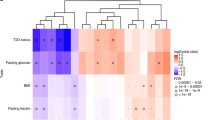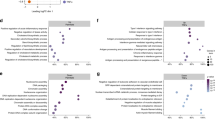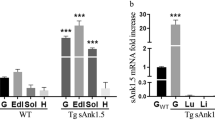Abstract
A small 12-kb haplotype upstream of the AKT1 gene has been found to be associated with insulin resistance phenotypes. We sought to define the functional consequences of the three component polymorphic loci (rs1130214, rs10141867, rs33925946) on AKT1 and the upstream ZBTB42 gene. 5′ RACE analysis of AKT1 transcripts in human skeletal muscle biopsies showed the predominant promoter to be 2.5 kb upstream of exon 2, and distinct from those promoters previously reported in rat. We then studied the effect of each of the three haplotype polymorphisms in transcriptional reporter assays in muscle, bone, and fat cell culture models, and found that each modulated enhancer and repressor activity are in a cell-specific and differentiation-specific manner. Our results in promoter assays are consistent with the human phenotype data; we found an anabolic effect on muscle and bone with increased mRNA expression of AKT1, and catabolic effect on fat with decreased expression. To test the hypothesis that rs10141867 affects transcription levels of the novel zinc finger protein ZBTB42 in vivo, we developed the allele-specific expression assay using Taqman technology to test for allelic differences within heterozygotes. The allele containing the derived polymorphism (haplotype H2) showed a 1.75-fold increase in expression in human skeletal muscle. Our data show a particularly complex effect of the component polymorphisms of a single haplotype on cells and tissues, suggesting that the coordination of different tissue-specific effects may have driven selection for the H2 haplotype. In light of the recent abundance of SNP association studies, our approach can serve as a method for exploring the biological function of polymorphisms that show significant genotype/phenotype associations.





Similar content being viewed by others
Abbreviations
- 3T3-L1:
-
Murine fat cells
- AKT1:
-
v-akt murine thymoma viral oncogene homolog 1
- ASE:
-
Allele-specific expression assay
- BMI:
-
Body mass index
- C2C12:
-
Murine muscle cells
- FAMUSS:
-
Functional SNPs associated with muscle size and strength
- FOXO:
-
Forkhead box O
- H1:
-
AKT1 haplotype H1
- H2:
-
AKT1 haplotype H2
- LPH:
-
Lactase-phlorizin hydrolase
- MAF:
-
Minor allele frequency
- MC3T3-E1:
-
Murine bone cells
- MM:
-
Homozygote mutant
- mTOR:
-
Mammalian target of rapamycin
- mZBTB42:
-
Mouse ZBTB42
- NN:
-
Homozygote normal
- PDK:
-
PI-dependent kinases
- PI3K:
-
Phosphatidylinositol 3 kinase
- PKB:
-
Protein kinase B
- PPARg:
-
Peroxisome proliferator-activated receptor gamma
- RACE:
-
Rapid Amplification of cDNA Ends
- RST:
-
Resistin
- S6K1:
-
S6 kinase
- SH2:
-
Src-homology 2
- SNPs:
-
Single nucleotide polymorphisms
- T2D:
-
Type 2 diabetes
- UTR:
-
Untranslated region
- WHO:
-
World Health Organization
- YRI:
-
Yoruban HapMap population
- ZBTB42:
-
Zinc finger and BTB domain containing 42
References
Alessi DR, Andjelkovic M, Caudwell B, Cron P, Morrice N, Cohen P, Hemmings BA (1996) Mechanism of activation of protein kinase B by insulin and IGF-1. EMBO J 15:6541–6551
Bajestan SN, Sabouri AH, Nakamura M, Takashima H, Keikhaee MR, Behdani F, Fayyazi MR, Sargolzaee MR, Bajestan MN, Sabouri Z, Khayami E, Haghighi S, Hashemi SB, Eiraku N, Tufani H, Najmabadi H, Arimura K, Sano A, Osame M (2006) Association of AKT1 haplotype with the risk of schizophrenia in Iranian population. Am J Med Genet B Neuropsychiatr Genet 141:383–386
Bodine SC, Stitt TN, Gonzalez M, Kline WO, Stover GL, Bauerlein R, Zlotchenko E, Scrimgeour A, Lawrence JC, Glass DJ, Yancopoulos GD (2001) Akt/mTOR pathway is a crucial regulator of skeletal muscle hypertrophy and can prevent muscle atrophy in vivo. Nat Cell Biol 3:1014–1019
Bouzakri K, Zachrisson A, Al-Khalili L, Zhang BB, Koistinen HA, Krook A, Zierath JR (2006) siRNA-based gene silencing reveals specialized roles of IRS-1/Akt2 and IRS-2/Akt1 in glucose and lipid metabolism in human skeletal muscle. Cell Metab 4:89–96
Brunn GJ, Hudson CC, Sekulic A, Williams JM, Hosoi H, Houghton PJ, Lawrence JC Jr, Abraham RT (1997) Phosphorylation of the translational repressor PHAS-I by the mammalian target of rapamycin. Science 277:99–101
Burgering BM, Coffer PJ (1995) Protein kinase B (c-Akt) in phosphatidylinositol-3-OH kinase signal transduction. Nature 376:599–602
Chen WS, Xu PZ, Gottlob K, Chen ML, Sokol K, Shiyanova T, Roninson I, Weng W, Suzuki R, Tobe K, Kadowaki T, Hay N (2001) Growth retardation and increased apoptosis in mice with homozygous disruption of the Akt1 gene. Genes Dev 15:2203–2208
Cheng JQ, Godwin AK, Bellacosa A, Taguchi T, Franke TF, Hamilton TC, Tsichlis PN, Testa JR (1992) AKT2, a putative oncogene encoding a member of a subfamily of protein-serine/threonine kinases, is amplified in human ovarian carcinomas. Proc Natl Acad Sci USA 89:9267–9271
Condorelli G, Drusco A, Stassi G, Bellacosa A, Roncarati R, Iaccarino G, Russo MA, Gu Y, Dalton N, Chung C, Latronico MVG, Napoli C, Sadoshima J, Croce CM, Ross J Jr (2002) Akt induces enhanced myocardial contractility and cell size in vivo in transgenic mice. Proc Natl Acad Sci 99:12333–12338
Cross DA, Alessi DR, Cohen P, Andjelkovich M, Hemmings BA (1995) Inhibition of glycogen synthase kinase-3 by insulin mediated by protein kinase B. Nature 378:785–789
DeBosch B, Treskov I, Lupu TS, Weinheimer C, Kovacs A, Courtois M, Muslin AJ (2006) Akt1 is required for physiological cardiac growth. Circulation 113:2097–2104
Devaney J, Gordish-Dressman H, Harmon B, Bradbury M, Devaney S, Harris T, Thompson P, Clarkson P, Price T, Angelopoulos T, Gordon P, Moyna N, Pescatello L, Visich P, Zoeller R, Seip R, Seo J, Kim B, Tosi L, Garcia M, Li R, Zmuda J, Delmonico M, Lindsay R, Howard B, Kraus W, Hoffman E (2010) AKT1 polymorphisms are associated with risk for metabolic syndrome. Hum Genet (submitted)
Emamian ES, Hall D, Birnbaum MJ, Karayiorgou M, Gogos JA (2004) Convergent evidence for impaired AKT1-GSK3beta signaling in schizophrenia. Nat Genet 36:131–137
Frazer KA, Elnitski L, Church DM, Dubchak I, Hardison RC (2003) Cross-species sequence comparisons: a review of methods and available resources. Genome Res 13:1–12
Ikeda M, Iwata N, Suzuki T, Kitajima T, Yamanouchi Y, Kinoshita Y, Inada T, Ozaki N (2004) Association of AKT1 with schizophrenia confirmed in a Japanese population. Biol Psychiatry 56:698–700
Jones HH, Priest JD, Hayes WC, Tichenor CC, Nagel DA (1977) Humeral hypertrophy in response to exercise. J Bone Joint Surg Am 59:204–208
Jones PF, Jakubowicz T, Hemmings BA (1991a) Molecular cloning of a second form of rac protein kinase. Cell Regul 2:1001–1009
Jones PF, Jakubowicz T, Pitossi FJ, Maurer F, Hemmings BA (1991b) Molecular cloning and identification of a serine/threonine protein kinase of the second-messenger subfamily. Proc Natl Acad Sci USA 88:4171–4175
Kellis M, Patterson N, Endrizzi M, Birren B, Lander ES (2003) Sequencing and comparison of yeast species to identify genes and regulatory elements. Nature 423:241–254
Konishi H, Kuroda S, Tanaka M, Matsuzaki H, Ono Y, Kameyama K, Haga T, Kikkawa U (1995) Molecular cloning and characterization of a new member of the RAC protein kinase family: association of the pleckstrin homology domain of three types of RAC protein kinase with protein kinase C subspecies and beta gamma subunits of G proteins. Biochem Biophys Res Commun 216:526–534
Krook A, Roth RA, Jiang XJ, Zierath JR, Wallberg-Henriksson H (1998) Insulin-stimulated Akt kinase activity is reduced in skeletal muscle from NIDDM subjects. Diabetes 47:1281–1286
Lin T-A, Lawrence JC Jr (1996) Control of the translational regulators PHAS-I and PHAS-II by insulin and cAMP in 3T3-L1 adipocytes. J Biol Chem 271:30199–30204
Liu AX, Testa JR, Hamilton TC, Jove R, Nicosia SV, Cheng JQ (1998) AKT2, a member of the protein kinase B family, is activated by growth factors, v-Ha-ras, and v-src through phosphatidylinositol 3-kinase in human ovarian epithelial cancer cells. Cancer Res 58:2973–2977
Ludlow AT, Lui D, Metter J, Ferrucci L, Roth SM (2007) Akt1 G205T polymorphism is associated with muscle strength. Med Sci Sports Exerc 39(5):S13
Matsui T, Li L, Wu JC, Cook SA, Nagoshi T, Picard MH, Liao R, Rosenzweig A (2002) Phenotypic spectrum caused by transgenic overexpression of activated Akt in the heart. J Biol Chem 277:22896–22901
North KN, Yang N, Wattanasirichaigoon D, Mills M, Easteal S, Beggs AH (1999) A common nonsense mutation results in alpha-actinin-3 deficiency in the general population. Nat Genet 21:353–354
Peng X-d, Xu P-Z, Chen M-L, Hahn-Windgassen A, Skeen J, Jacobs J, Sundararajan D, Chen WS, Crawford SE, Coleman KG, Hay N (2003) Dwarfism, impaired skin development, skeletal muscle atrophy, delayed bone development, and impeded adipogenesis in mice lacking Akt1 and Akt2. Genes Dev 17:1352–1365
Riska KL, Devaney J, Chen TC, Matos M, Hoffman EP, Clarkson PM (2007) AKT1 association with body composition. Med Sci Sports Exerc 39(5):S14
Rondinone CM, Carvalho E, Wesslau C, Smith UP (1999) Impaired glucose transport and protein kinase B activation by insulin, but not okadaic acid, in adipocytes from subjects with Type II diabetes mellitus. Diabetologia 42:819–825
Sandri M, Sandri C, Gilbert A, Skurk C, Calabria E, Picard A, Walsh K, Schiaffino S, Lecker SH, Goldberg AL (2004) Foxo transcription factors induce the atrophy-related ubiquitin ligase atrogin-1 and cause skeletal muscle atrophy. Cell 117:399–412
Schwab SG, Hoefgen B, Hanses C, Hassenbach MB, Albus M, Lerer B, Trixler M, Maier W, Wildenauer DB (2005) Further evidence for association of variants in the AKT1 gene with schizophrenia in a sample of European sib-pair families. Biol Psychiatry 58:446–450
Shaw M, Cohen P, Alessi DR (1998) The activation of protein kinase B by H2O2 or heat shock is mediated by phosphoinositide 3-kinase and not by mitogen-activated protein kinase-activated protein kinase-2. Biochem J 336(Pt 1):241–246
Shiojima I, Sato K, Izumiya Y, Schiekofer S, Ito M, Liao R, Colucci WS, Walsh K (2005) Disruption of coordinated cardiac hypertrophy and angiogenesis contributes to the transition to heart failure. J Clin Invest 115:2108–2118
Stitt TN, Drujan D, Clarke BA, Panaro F, Timofeyva Y, Kline WO, Gonzalez M, Yancopoulos GD, Glass DJ (2004) The IGF-1/PI3K/Akt pathway prevents expression of muscle atrophy-induced ubiquitin ligases by inhibiting FOXO transcription factors. Mol Cell 14:395–403
Tang S, Huang T (2010) Characterization of mitochondrial DNA heteroplasmy using a parallel sequencing system. Biotechniques 48:287–296
Ueki K, Yamamoto-Honda R, Kaburagi Y, Yamauchi T, Tobe K, Burgering BM, Coffer PJ, Komuro I, Akanuma Y, Yazaki Y, Kadowaki T (1998) Potential role of protein kinase B in insulin-induced glucose transport, glycogen synthesis, and protein synthesis. J Biol Chem 273:5315–5322
Vanhaesebroeck B, Alessi DR (2000) The PI3K-PDK1 connection: more than just a road to PKB. Biochem J 346(Pt 3):561–576
Yang ZZ, Tschopp O, Di-Poi N, Bruder E, Baudry A, Dummler B, Wahli W, Hemmings BA (2005) Dosage-dependent effects of Akt1/protein kinase Balpha (PKBalpha) and Akt3/PKBgamma on thymus, skin, and cardiovascular and nervous system development in mice. Mol Cell Biol 25:10407–10418
Author information
Authors and Affiliations
Corresponding author
Rights and permissions
About this article
Cite this article
Harmon, B.T., Devaney, S.A., Gordish-Dressman, H. et al. Functional characterization of a haplotype in the AKT1 gene associated with glucose homeostasis and metabolic syndrome. Hum Genet 128, 635–645 (2010). https://doi.org/10.1007/s00439-010-0891-7
Received:
Accepted:
Published:
Issue Date:
DOI: https://doi.org/10.1007/s00439-010-0891-7




